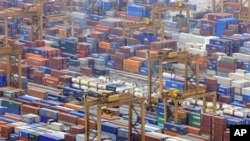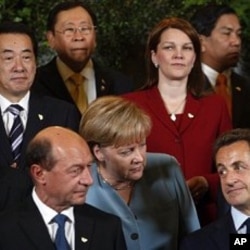Since the middle of this decade, free trade agreements have blossomed in Asia, partly because of the failure of the World Trade Organization negotiations. Some economists and officials have argued that these bilateral agreements undermine efforts toward a globally binding free trade pact. But Heda Bayron in Hong Kong recently spoke with two trade experts she first interviewed in 2004, and reports they see a new push to link these agreements into one.
Pushing free trade
The leaders of the Asia Pacific Economic Cooperation grouping meet in Yokohama, Japan, this week to again push for trade liberalization among its 21 members.
The goal of cutting tariffs by 2020 was first shaped in Bogor, Indonesia, in 1994. But it has been eclipsed by the emergence of bilateral free trade agreements. These have allowed countries to negotiate the free flow of goods and services faster than by working out pacts with multiple partners. Countries such as South Korea, China and Singapore are among APEC members that have entered into several FTAs in recent years.
Shujiro Urata, an economics professor at Waseda University in Japan, who spoke with VOA six years ago about bilateral trade agreements, says the failure of the World Trade Organization trade liberalization talks in 2006 encouraged more FTAs in recent years.
"It's a very important alternative to the WTO. I think one interesting difference between say, the earlier periods and the future, is that there is a trend toward expanding membership by merging or docking. I think we are seeing a broadening from bilateral to pluri-lateral FTAs," said Shujiro Urata.
US backs Trans-Pacific Partnership
One idea that has received fresh backing from the United States is the Trans-Pacific Partnership, a super FTA that would eliminate tariffs without conditions. Only two of the United States' 14 FTAs are with countries in the Asia-Pacific - Singapore and Australia.
Brunei, Chile, New Zealand and Singapore committed to the TPP in 2006. Australia, Malaysia, Peru and Vietnam have also joined the talks along with the U.S.
The Japanese government worries their country is lagging behind in terms of FTAs. Business lobby groups urge Tokyo to join the TPP, but the highly subsidized agricultural sector opposes it.
"This is an occasion that Japan can take advantage of in broadening Japan's FTA coverage and also I'm in favor of FTA because that would promote structural adjustment, especially in the agricultural sector," said Urata. "Without opening up our economy to the rest of the world, (the outlook for the) Japanese economy in the future is quite pessimistic."
South Korea recently sealed an FTA with the European Union. But the U.S. Senate has failed to ratify a U.S.-Korea FTA, agreed to 2007.
EU engages negotiations
The EU also is negotiating deals with Malaysia, Vietnam, Singapore and India.
Professor Urata says many countries are eager to link up with East Asia because it is seen as the next growth center of the world.
"In the future this will be the market of the world," added Urata. "So the EU, the U.S. and many other countries are interested in having their foothold in East Asia."
As trade with Asia increased in recent years, Latin American countries also made their move. Chile was the first Latin American country to reach an agreement with China, while its FTA with South Korea came into force in 2004. Peru's FTA with China came into force earlier this year, while it concluded one with South Korea in September, and soon with Thailand.
Latin America - Asia trade prospects
Fernando Gonzalez-Vigil, an economics professor at the Universidad del Pacifico in Lima, Peru, expects more FTAs between Latin American and Asian countries.
"The quality of these trans-Pacific agreements is very high compared both to agreements within the Americas and to agreements within East Asia and Oceania," said Gonzales. "From the point of view of the deepness of tariff elimination, the commitments on non-tariffs measures and the commitments on trade in services in general, including the commitments on investment measures, they really rank very well."
Gonzalez-Vigil says the TPP could be a mechanism for existing trans-Pacific FTAs to be linked together to benefit all.
"So far the negotiating teams have agreed that everything that is related to market access either in goods or services would most likely be negotiated and committed at the bilateral level. So it would be a nice architecture between the TPP as a pluri-lateral agreement on rules and basic principles, which is going to be at the same time the framework for X number of bilateral agreements," said Gonzales. "Meaning that, for instance, our U.S.-Peru FTA will not be terminated or substituted for TPP. It will co-exist."
Crucial period for APEC
Japan and the United States appear eager to push for concrete results in the APEC meeting this week to set a new direction for the grouping when the U.S. hosts the summit next year. This year marks the deadline for industrialized members to meet trade liberalization commitments under the Bogor goals.
Urata says APEC is entering a crucial period in deciding its future.
"This year, they are to discuss a new economic growth model for APEC members. That may lead to increasing interest for APEC by APEC members," said Urata. "If these two years are successful, then I think APEC will be pretty much revived."
However, China, now Asia's biggest economy, has yet to officially express its position on the TPP. Some trade analysts say that without Chinese participation, the TPP would have less benefit. And many worry that ongoing trade friction between China and the U.S., and Beijing's territorial dispute with Japan, could overshadow efforts toward a trans-Pacific free trade zone.












